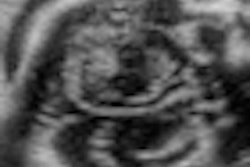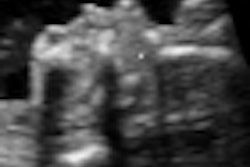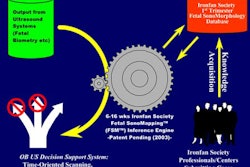Training in advanced prenatal ultrasound techniques such as 3D/4D and fetal echocardiography is often lacking for maternal-fetal medicine (MFM) fellows, according to a Stanford University-led research team.
In a survey of associate members of the Society for Maternal-Fetal Medicine (SMFM), the study team found that nearly 39% of the fellows did not receive official training in 3D/4D ultrasound, and 28% did not receive training in fetal echocardiography.
"Greater mentorship and didactic and structured teaching for 2D, 3D, and 4D [ultrasound] and fetal echocardiography are very much needed," said Dr. Yair Blumenfeld of Stanford.
Blumenfeld and colleague Dr. Amen Ness presented the research project's findings in a pair of talks at the recent American Institute of Ultrasound in Medicine (AIUM) annual meeting in New York City.
MFM fellowships run for three years, about half of which is protected research time. The remaining time is for clinical use, divided between prenatal diagnosis in ultrasound and managing high-risk pregnancies in both the outpatient and inpatient settings, Blumenfeld said.
Following up on recent MFM fellowship training surveys, the researchers sought to gather objective data on MFM fellowship experience and training with ultrasound as well as 3D/4D ultrasound. They emailed a 52-item, Internet-based prenatal diagnosis survey to 458 associate SMFM members, a category that includes both fellows and recent graduates who are not yet MFM-board certified.
There were 148 submissions for a 32% response rate. Of these, 92% of respondents were at least in their second year of fellowship and 52% were postfellowship. Seventy-one percent were female. The majority of respondents were 30 to 35 years old and they were fairly well distributed across the country, according to Blumenfeld.
Fifty-eight percent of fellows spent at least 20% of their fellowship time performing prenatal ultrasound, but about 10% of fellows spent less than 10% of their fellowship time in prenatal diagnosis during their three years of training, he said.
The researchers also noted that the majority of fellows are being trained in 2D ultrasound by sonographers, followed closely by perinatologists. Approximately 20% are trained by radiologists. Only 7% did not receive official training in 2D ultrasound.
As for 3D/4D, the majority of fellows were trained by sonographers, again followed closely by perinatologists. Thirty-nine percent did not receive any official training in 3D/4D ultrasound.
Perinatologists trained more fellows in fetal echocardiography, followed by pediatric cardiologists. Twenty-eight percent of fellows did not receive any official training in echocardiography over the course of their training.
When asked if they had a designated ultrasound mentor, only 36.4% of fellows could identify one at their institution. About 1.5% had one outside their institution, according to Blumenfeld.
When asked what their role was in the ultrasound unit, the vast majority of fellows said their role was mimicking the sonographer.
"[That means] performing nuchal translucency exams, performing [fetal] growth ultrasound, and performing anatomy scans," he said. "Interestingly, about 60% of fellows felt that their role was the same as trained physicians, meaning that they actually sign off on scans despite not having completed their fellowship. They were already forced to act as attending physicians, signing off on the scans that they were reading."
When asked how many of their research projects involved prenatal diagnosis including ultrasound, 48% reported that they did not perform any in this area during their fellowship, Blumenfeld said. And only 5% applied for research funds in this area.
"Despite spending over 20% of their time in prenatal diagnosis, research experience during the course of fellowship in prenatal diagnosis in ultrasound remains very limited for most fellows," he said.
3D/4D
In the second part of the survey, the research team zeroed in on 3D/4D ultrasound training and experience. Fellows typically found that experience to be lacking.
"Fellows believe there is a need to increase 3D training," said Ness. "And most would like to see the use of multiple educational forums to complement fellowship experience."
Of the survey respondents, 33% said they did not perform any 3D/4D ultrasound. In addition, 39% had no formal training in 3D/4D, while only 51% reported that they personally knew how to do 3D/4D.
Fifty-five percent of respondents said that fewer than 20% of their MFM faculty performed 3D/4D ultrasound. As for those who received training, 64% were taught by sonographers. Forty-three percent said they were self-taught, Ness said.
When asked to characterize their 3D/4D abilities, approximately 56% of respondents said they could obtain basic images, such as performing basic surface rendering. But only about 10% believed they could use 3D/4D techniques such as multiplanar imaging for additional evaluation of anomalies, Ness said.
"So basically, most of the 3D knowledge that these fellows and postfellows have is of a limited degree," he said.
The researchers also queried respondents on the anomalies for which they would use 3D/4D. Facial anomalies were indicated on 91% of surveys, followed by extremity anomalies (61%), ambiguous genitalia (43%), and central nervous system anomalies (43%).
When asked how much time 3D/4D added to their routine examination, about 40% said they allotted no additional time. Up to 15 minutes were allotted by 44% of respondents, and only 1% scheduled a separate appointment for 3D/4D.
Among those not performing 3D/4D, 53% did not receive any formal 3D/4D ultrasound training, compared with 26% of fellows who do perform 3D/4D ultrasound. And 67% of those not performing 3D/4D ultrasound spend less than 20% of their time in prenatal diagnosis, compared with 25% of the overall survey population.
Overall, 76% of respondents believe that 3D/4D has clinical utility, and most would like to see formalized training in their fellowship, Ness said.
Ness noted that the proceedings from the AIUM Consensus Conference in 2005 encouraged manufacturers, experts, and societies to make it easier to learn how to perform 3D ultrasound examinations with more accessible opportunities such as online and hands-on courses. But fellowship training wasn't addressed, he said.
"Most survey respondents believe that 3D ultrasound is an important tool, [but] some fellowships still provide what appears to be insufficient and inadequate time," Ness said.




















